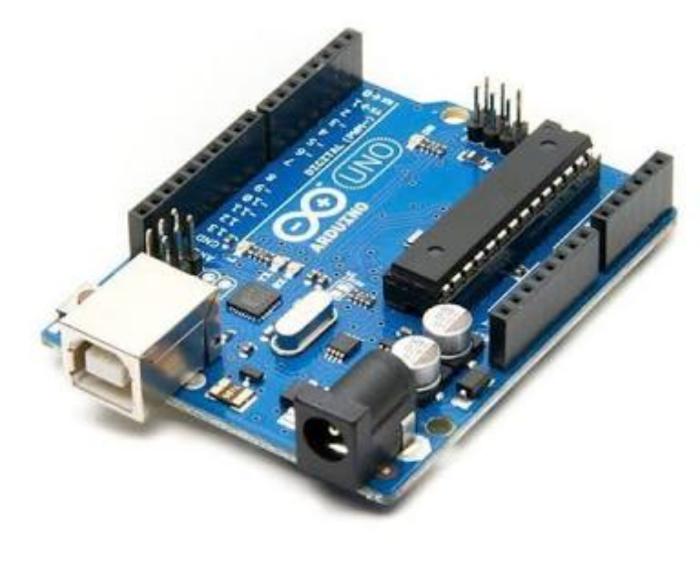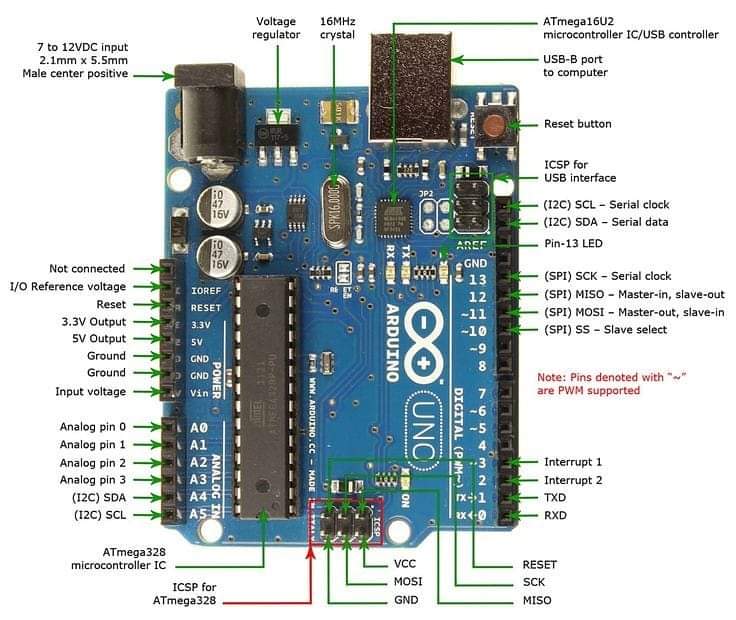In this article, I am going to talk about Arduino Uno pinout and its features Let’s start…
The Arduino Uno board:
In Italian Uno means one. The Arduino Uno is an open-source microcontroller-based development board. ATmega328p is the microcontroller used in Arduino Uno. Its software is also open-source. It is simply ideal for hobbyists as well as professionals. The Arduino Uno board is small and handy approximately 7cm long and 5cm wide. It is having 14 digital input/output pins, out of which 6 can be used as PWM output and 6 analog inputs. You should also read various Arduino boards
The Uno has a 16 MHz crystal oscillator which is the heart of the board. Also, it has a USB connection, an ICSP header, a power jack, and a reset button. All the necessary stuff is required for the microcontroller.
You need to simply connect it to a computer with a USB cable for programming and power it with a AC-to-DC adapter or battery to get started to run.
The Arduino Uno does not use the FTDI USB-to-serial driver chip. it features the Atmega8U2 microcontroller chip programmed as a USB-to-serial converter.
The Arduino open-sourced IDE drivers can be downloaded for free from its official website Arduino. cc
Features of the Arduino UNO:
1.) Microcontroller: ATmega328.
2.)Operating Voltage: 5V.
3.) Input Voltage (recommended): 7-12V.
4.) Input Voltage (limits): 6-20V.
5.) Digital I/O Pins: 14 (out of which 6 provide PWM output).
6.) Analog Input Pins: 6.
7.) DC Current per I/O Pin: 40 mA.
8.) DC Current for 3.3V Pin: 50 mA.
9.) Flash Memory: 32 KB of which 0.5 KB is used by bootloader.
8.) SRAM: 2 KB (ATmega328).
9.) EEPROM: 1 KB (ATmega328).
10.) Clock Speed: 16 MHz.
Arduino UNO pinout:
Here is an image showing Arduino Uno pinout
Check out here for Introduction To Arduino Uno tutorials.
Power and USB:
There is a USB type-B Port on the board which is used to program and power the microcontroller IC also there is a separate power input port to give external voltage via regulator 7805.
VCC and ground pins:
There are three ground pins on the board also there is a 5volt output and and a 3.3volt output for other components.
Input and Output (I/O) pins:
There are total 14 digital pins on the Arduino Uno board. They can be configured to input or outputs, functions like using pinMode(), digitalWrite() and digitalRead(). Their operation voltage is 5 volt. Each pin can provide or take a maximum of 40 mA and has an internal pull-up resistor.
Also some pins have special functions:
Serial Data pins:
pins A0 (RX) and A1 (TX) are Used to receive (RX) and transmit (TX) TTL( Transistor Transistor logic) serial data. These pins are connected to the pins of the ATmega8U2 USB-to-TTL Serial Chip.
External Interrupt pins:
pins 2 and 3 can be configured to trigger an interrupt, a change in value. See attachInterrupt() function for more details.
Pulse width modulation (PWM) pins:
pin number 3, 5, 6, 9, 10, and 11. Provide 8-bit PWM output by using the analogWrite() function.
Serial Peripheral Interface (SPI):
pins 10 (SS), 11 (MOSI), 12 (MISO), 13 (SCK) pins support SPI communication between two microcontrollers using the SPI library.
LED Pin:
The pin number 13 is connected to LED, When the pin value is HIGH the LED is on, when the pin is LOW, it’s off.
Analog input pins:
The Uno has 6 analog inputs, labeled A0 to A5. Each of them provides 10 bits resolution (i.e. 1024 different values). They measure from ground to 5 volts. They can be used to measure voltage and current.
Two-Wire Interface (TWI) pins:
pin A4 is SDA( serial data) pin and A5 is SCL(serial clock) pin pin. Support TWI communication using the Wire library it is used to connect LCD display.
AREF pin:
it can be used as a Reference voltage for the analog inputs, Used with analogReference().
Reset pin:
can be useful to reset the microcontroller. Typically used to add a reset button to shields which block the one on board reset button.



